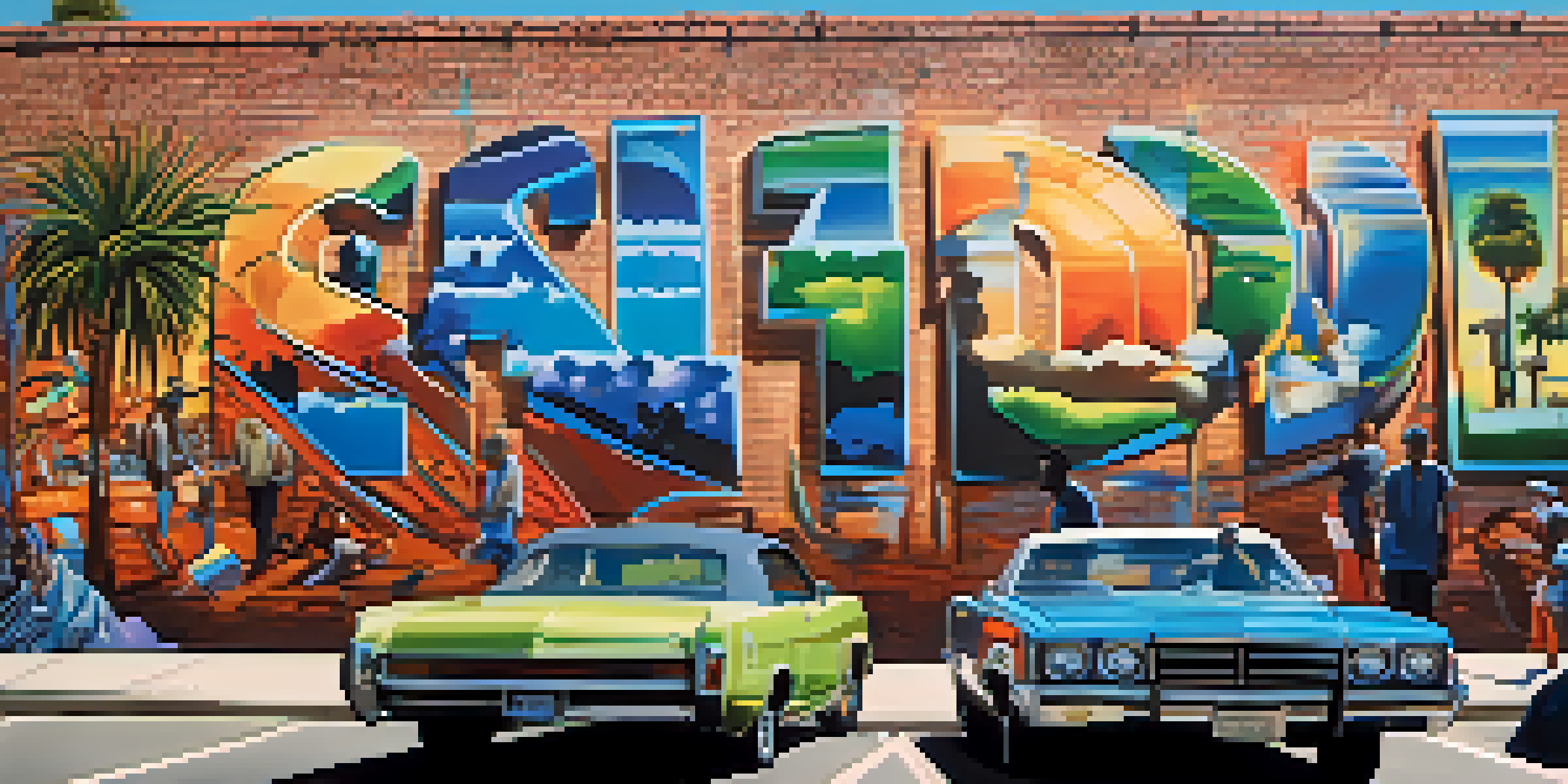Compton and the Evolution of West Coast Rap

The Birthplace of West Coast Rap: Compton's Roots
Compton, California, is often recognized as the cradle of West Coast rap. In the late 1980s, the city became a hotspot for groundbreaking artists who would redefine hip-hop. With its vibrant street culture and social struggles, Compton provided the perfect backdrop for storytelling through music. This dynamic environment birthed a unique sound that set itself apart from the East Coast's rap scene.
Rap is something you do. Hip hop is something you live.
The emergence of groups like N.W.A., who hailed from Compton, marked a pivotal moment in music history. Their raw lyrics and innovative production techniques resonated with listeners, highlighting the realities of life in the inner city. This authenticity helped to lay the groundwork for what would become known as 'gangsta rap,' a subgenre that would influence countless artists across the globe.
As Compton became synonymous with this new sound, it attracted attention from both fans and media alike. The city’s stories of resilience and struggle found their way into the hearts of many, making Compton not just a location but a symbol of a cultural movement. This initial wave of creativity set the stage for the evolution of West Coast rap.
N.W.A and the Rise of Gangsta Rap
N.W.A, or Niggaz Wit Attitudes, emerged as a groundbreaking force in the late '80s. Their debut album, 'Straight Outta Compton,' was a game-changer that put the city on the map. With unapologetic lyrics and aggressive beats, they painted a vivid picture of life in Compton, highlighting issues like police brutality and systemic inequality. Their music was not just entertainment; it was a call to action.

The group's impact was monumental, sparking discussions around freedom of speech and censorship in music. They faced immense backlash from authorities and critics, yet this only fueled their fire. N.W.A's raw honesty resonated with many, particularly youth who saw their own struggles reflected in the lyrics. In doing so, they opened doors for other artists to share their stories.
Compton: Cradle of West Coast Rap
Compton's vibrant street culture and social struggles laid the foundation for the emergence of West Coast rap, making it a symbol of a cultural movement.
The influence of N.W.A extended far beyond their music, laying the foundation for countless West Coast artists who followed. Their legacy is evident in the work of contemporary rappers who continue to reference their style and themes. As the pioneers of gangsta rap, N.W.A not only shaped the sound of West Coast hip-hop but also its cultural identity.
Snoop Dogg: The Smooth Transition to Mainstream
As the '90s rolled in, Snoop Dogg emerged as a key figure in West Coast rap, bringing a more laid-back style to the genre. His debut album, 'Doggystyle,' showcased a unique blend of gangsta rap and G-funk, making it a commercial success. Snoop's smooth delivery and charismatic persona captured audiences, allowing him to cross over into the mainstream without losing his roots.
I think music is a reflection of the culture, and I think the culture is a reflection of the music.
Snoop’s collaboration with Dr. Dre on 'The Chronic' further solidified his place in hip-hop history. This iconic album not only introduced G-funk, characterized by its funky grooves and melodic hooks, but also set the standard for West Coast production. The partnership showcased how West Coast rap could evolve while maintaining its gritty authenticity.
Snoop Dogg's rise to fame also highlighted the potential for West Coast rap to reach a broader audience. He helped demystify the harsh realities depicted in earlier gangsta rap, making it accessible to listeners outside of Compton. This shift contributed to the genre's evolution and popularity, paving the way for a new generation of artists.
The Impact of Dr. Dre and the G-Funk Era
Dr. Dre is often credited as the architect of the G-funk sound, which became synonymous with West Coast rap in the '90s. This style incorporated funk samples, melodic synthesizers, and smooth bass lines, creating a laid-back yet compelling vibe. Dre's production on albums like 'The Chronic' not only showcased his talent but also influenced countless artists and producers.
The G-funk era was characterized by a shift in lyrical themes as well. While earlier gangsta rap focused heavily on street life, G-funk often included themes of partying, relationships, and success. This transition allowed for a broader appeal and helped introduce West Coast rap to a more diverse audience. Artists began to explore new narratives while still celebrating their cultural backgrounds.
N.W.A: Pioneers of Gangsta Rap
N.W.A's groundbreaking music and unapologetic lyrics not only defined gangsta rap but also sparked important conversations about freedom of speech and social issues.
Dr. Dre's influence extended beyond his own music, as he mentored many young artists, including Eminem and 50 Cent. His ability to spot talent and shape it into something incredible ensured the longevity of West Coast rap. This era not only solidified Compton's place in hip-hop but also showcased the innovation that defined the West Coast sound.
The 2000s: New Voices and Diverse Styles
The 2000s marked a new chapter for West Coast rap, with a wave of fresh voices emerging from Compton and surrounding areas. Artists like The Game brought a modern twist to gangsta rap, blending it with contemporary sounds and themes. His debut album, 'The Documentary,' showcased a balance of street authenticity and mainstream appeal, proving that the West Coast still had much to offer.
Meanwhile, Kendrick Lamar, who would later be hailed as one of the greatest rappers of his generation, began making waves in the early 2010s. His work, particularly 'good kid, m.A.A.d city,' offered a deeply personal narrative that reflected the complexities of life in Compton. Lamar's lyrical prowess and innovative storytelling elevated West Coast rap, proving it could tackle profound social issues while remaining engaging.
This era also saw the rise of various subgenres, including alternative and experimental rap. Artists like Tyler, The Creator and Odd Future brought a unique perspective, incorporating elements of punk and R&B into their music. This diversity showcased the adaptability of West Coast rap, allowing it to evolve while still honoring its roots.
Social Media and the Globalization of West Coast Rap
With the advent of social media, West Coast rap found new platforms for exposure and connection. Artists could now share their music directly with fans, transcending geographical boundaries. This democratization of music allowed for a global audience to discover and appreciate the unique sound of West Coast rap, further enhancing its reach and influence.
Platforms like YouTube and SoundCloud became essential for emerging artists to showcase their talent. This led to the rise of numerous independent musicians who drew inspiration from the legends of Compton while adding their own flavor. The ability to share music instantly created a vibrant community where collaboration and creativity flourished.
Global Reach of West Coast Rap
Social media has allowed West Coast rap to transcend geographical boundaries, enabling artists to connect with a global audience and diversify the genre.
As West Coast rap continued to thrive online, it attracted attention from international fans and artists alike. Collaborations with musicians from various genres and backgrounds further enriched the sound, proving that hip-hop could unite people across cultures. The globalization of West Coast rap not only expanded its audience but also its impact on the music industry as a whole.
Conclusion: Compton's Enduring Legacy in Hip-Hop
Compton's influence on West Coast rap is undeniable, shaping the genre's sound, themes, and cultural identity. From the raw authenticity of N.W.A to the smooth grooves of Snoop Dogg, the city has produced a wealth of talent that continues to inspire. As new artists emerge, they often pay homage to the legends of Compton while carving out their own paths in the industry.
The evolution of West Coast rap illustrates the genre's ability to adapt and resonate with younger generations. With each new wave of artists, Compton's stories of struggle and triumph remain relevant, showcasing the power of music as a tool for social commentary. This continuity ensures that the legacy of Compton will live on for years to come.

As we look towards the future, it's clear that Compton will continue to be a crucial part of hip-hop's narrative. With its rich history and vibrant culture, the city will likely inspire more artists to share their voices and experiences. Ultimately, Compton's enduring legacy is a testament to the transformative power of music in shaping lives and communities.